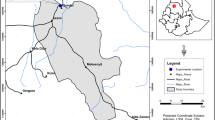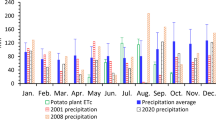Summary
Irrigated winter barley (Hordeum vulgare L.) can be a profitable alternative to some low profit major crops in the Texas High Plains. A six-year evaluation of yield response related to total spring irrigation water, applied by surface methods (furrow), and seasonal precipitation resulted in a multivariate function explaining 74% of the yield variation. Predicted yields varied from a low of 3.69 Mg ha−1 to a maximum 6.18 Mg ha−1 with 0 and 389 mm, respectively, based on average monthly precipitation quantities. Precipitation is skewed to less than average in th semi-arid Texas High Plains. Using modal precipitation amounts of 40% of average precipitation, yield estimates were reduced to 2.29 Mg ha−1 with zero spring irrigation and to 5.63 Mg ha−1 at the peak with 450 mm. A second multivariate yield response function related to alternative timings of single and multiple spring irrigations explained 76% of the variation in yields. Among all combinations of 1, 2, 3, and 4 spring irrigations, irrigation water-use efficiency was estimated to be highest with one application at the boot stage of development. All other single and combinations of multiple irrigations resulted in lower water-use efficiencies. A comparison of enterprise budgets of four irrigation timing alternatives and levels of application indicated highest profit over variable costs, $ 287 ha−1, was attained by applying a total of 307 mm in three spring applications at the boot, head, and milk stages. A lower level of 217 mm applied at boot and milk stages was $ 12 ha−1 less profitable and a higher level of 425 mm was $ 24 ha−1 less profitable. When fixed costs of irrigation facilities, land, and machinery were considered, returns to management and risk were highest, $ 101 ha−1, with 217 mm. Using 40% of average precipitation, profits were reduced $ 65 ha−1 with 217 mm and $ 69 ha−1 with 307 mm spring irrigation levels.
Similar content being viewed by others
References
Campbell WF, Wagenet RJ, Bamatraf AM, Turner DL (1980) Path coefficient analysis of correlation between stress and barley yield components. Agron J 72:1012
Cater KE, Stoker R (1985) Effects of irrigation and sowing date on yield and quality of barley and wheat. N Z J Exp Agron 13:77–83
Christensen NW, Killern RK (1981) Wheat and barley growth and N fertilizer utilization under sprinkler irrigation. Agron J 73:307–312
Day AD, Thompson RK (1975) Effects of soil moisture regimes on the growth of barley. Agron J 67:430–433
Eck HV (1988) Wheat fertility needs. Proc. of Wheat Field Day, USDA Production and Conservation Research Laboratory, Bushland, Texas, May 26, 1988, p 49–52
Heady EO (1952) Economics of agricultural production and resource use. Prentice-Hall Inc, Englewood Cliffs NJ
Kirby EFM (1968) The response of some barley varieties to irrigation and nitrogen fertilizer. J Agric Sci Camb 71:47–52
Lugg DG, Tubaileh AS, Kallsen CE, Sammis TW (1988) Irrigation effects on rooting patterns of barley. Irrig Sci 9:27–43
Mogensen V, Overgaard (1980) Drought sensitivity at various growth stages of barley in relation to relative evapotranspiration and water stress. Agron J 72:1033–1038
Musick JT, Pringle FB, Harman WL, Stewart BA (1988) Long-term irrigation trends — Texas High Plains. ASAE paper no. SWR 88-103, Southwest Region Meeting, Lubbock, Texas
Power JF, Bond JJ, Sellner WA, Olson HM (1973) Effect of supplemental water on barley and corn production in a subhumid region. Agron J 65:464–467
Schneider AD, Musick JT, Dusek DA (1969) Efficient wheat irrigation with limited water. Trans ASAE 12:23–26
Sepaskhah AR (1978) Time and frequency of irrigation in relation to growth stages of barley. 1978. Agron J 70:731–734
Shipley JL (1977) Scheduling irrigations with limited water. Proc 5th Annual High Plains Grain Conf Oklahoma State Univ, Stillwater OK, pp 7–24
Singh KP, Kumar V (1981) Water use and water-use efficiency of wheat and barley in relation to seeding dates, levels of irrigation and nitrogen fertilization. Agr Water Mgmt 3:305–316
SAS (1985) SAS/STAT guide for personal computers. SAS Institute Inc, Cary NC
Texas Agricultural Extension Service (1988) Texas crop enterprise budgets — Texas Panhandle district. B-1241 (CO1), College Station, Texas
Texas Agricultural Statistics Service (1981) Texas historic crop statistics, 1966–1980. Texas Department of Agriculture, Austin, Texas
Texas Agricultural Statistics Service (1981–1985) Small grain statistics. Texas Department of Agriculture, Austin Texas
Unger PW, Pringle FB (1986) Sherm soils-distribution, importance, variability and management. B-1513, Texas Agr Exp Station College Station TX
Wagenet RJ, Campbell WF, Bamatraf AM, Turner DL (1980) Salinity, irrigation frequency, and fertilization effects on barley growth. Agron J 72:969–974
Author information
Authors and Affiliations
Additional information
Respectively, agricultural economist, research scientist, and research associate, Texas Agr. Exp. Station, Amarillo, Texas; Emeritus Extension agronomist, Texas Agr. Ext. Service, Amarillo, Texas; agricultural engineer, Texas Agr. Exp. Station, Amarillo, Texas
Rights and permissions
About this article
Cite this article
Harman, W.L., Regier, C., Lansford, V.D. et al. Barley yield response to irrigation and potential profits in the Texas High Plains. Irrig Sci 11, 163–172 (1990). https://doi.org/10.1007/BF00189454
Received:
Issue Date:
DOI: https://doi.org/10.1007/BF00189454




